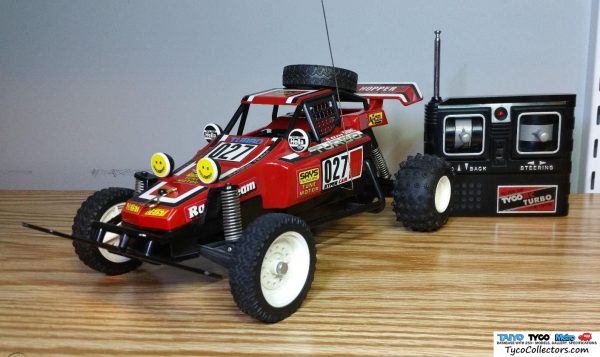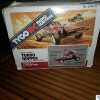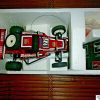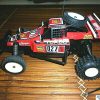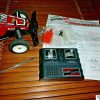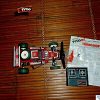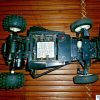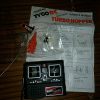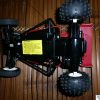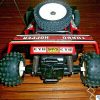The Tyco Turbo Hopper MK2 is the second version of the Turbo Hopper series, a radio controlled car manufactured by Taiyo (Japan), and released into the US, UK, and other markets worldwide in 1988 following the incredible success of the original MK1 release in late 1986.
Note: MK1, MK2, etc. is not an official designation, and is simply how Tyco Collectors (and now the wider community) refers to the first release, upgraded second release, upgraded third release, etc.

Origins
As with the original, the Turbo Hopper MK2 was the first radio controlled vehicle that many of us ever owned, and followed on from the success of the Taiyo Jet Hopper MK1 in Japan, and the Metro Jet Hopper MK1 in Australia (from which it copied the box art entirely, simply replacing ‘Metro RC’ with ‘Tyco RC’) and continued the Turbo Hopper’s reign as a worldwide phenomenon.
Making RC more accessible
Its success can be attributed to the simple fact that it made this type of higher quality, off-road bashing, relatively high speed RC accessible to the masses, with the average Australian, American, and European kid seeing the exciting TV commercials in between their favorite cartoons, and sending mum and dad off to the local toy store or department store where it was readily available.

Unlike the Tamiya hobby-grade cars also popular at the time, the Taiyo/Tyco cars came pre-built, ready-to-run (RTR) as we’d call it today, needing only 8xAA batteries and a 9V for the controller. They were also significantly cheaper than hobby grade cars.


Most exciting of all, the Hopper came with ‘Turbo’ mode which was genius marketing to kids, enabling a further press down of the accelerator to enter the highest speed setting, in addition to the Low/High speed gearbox switch on the back.
Features and Performance
This 2nd version of the Turbo Hopper, which I refer to as the Turbo Hopper MK2 (Mark II) had several notable improvements on its predecessor that I’m aware of.
- Lower profile (thinner) front tires
- Stronger, solid front bumper, with no text cutout weakening it
- ‘Turbo’ in blue in front of the cabin
- Top Speed of 25km/h
- LED charge light, which was a nice touch in the 80s when LEDs were not as common place as today


Identify a Turbo Hopper MK2
As indicated in the above image:
A. Lower profile front tires
B. Solid front bumper with no cut-out text
C. “Turbo” in bright blue on the front
D. LED charge light

Do you know of other distinguishing features of the MK1, MK2 Turbo Hoppers that I’ve missed? Leave a comment below, or contact me so I can update the page and give you credit.
Other versions of the Turbo Hopper
In Japan, a third version would be released in 1987, the Taiyo Jet Hopper MK3 which I suspect must also have been released in the United States and elsewhere, but I’m yet to find conclusive photos. It featured much improved front and rear tires with a stronger, longer lasting tread, and other minor improvements.
The Aero Turbo Hopper series would also be released side-by-side with the regular Turbo Hoppers. These featured an ‘aerodynamic’ body, which was a popular ‘futuristic’ look at the time, however in my personal opinion the ultimate Turbo Hopper had to be the Tyco Super Turbo Hopper 4WD (1989) and the Tyco 4 Wheel Drive Super Turbo Hopper (1988)
Go and take a look at those and tell me you don’t want one!
Availability and Collectability
Clearly one of the most collectable toys from the era, without question.
As for availability, in today’s market you really can’t be picky with what version of the Turbo Hopper you get sadly, as good condition cars are becoming so rare. Worst of all, you may find an absolutely MINT car, in a perfect box, yet the tires are completely spoiled due to deterioration of the rubber compound. In this case my advice is to buy anyway (for obviously a discount) and purchase some 3D printed tires as these are getting better every year. Alternatively, replace the tires with some used ones from a more easily obtainable parts car.
In the past, my advise was to seek out an original Japanese/European 1986 Jet Hopper MK1 which were all Made in Japan, since these are typically kept in near perfect condition, with tires, box, etc. However these are virtually unavailable now, and all have “passive” steering (only turns when moving) which some people find annoying.
Since then my recommendation has moved to a 1987 Jet Hopper MK3 which has all the benefits plus they’re slightly more obtainable, and in my experience the front/rear tires are more likely to be in good condition.



















